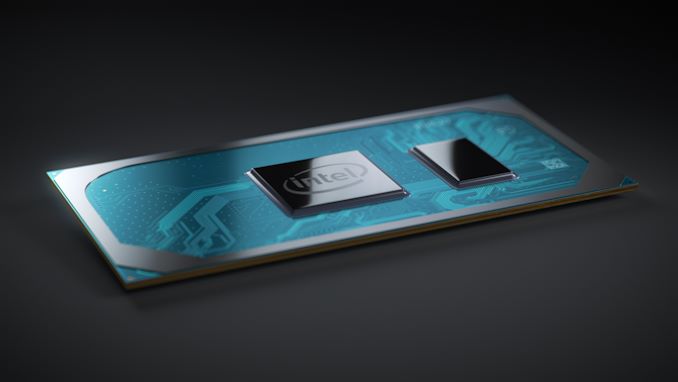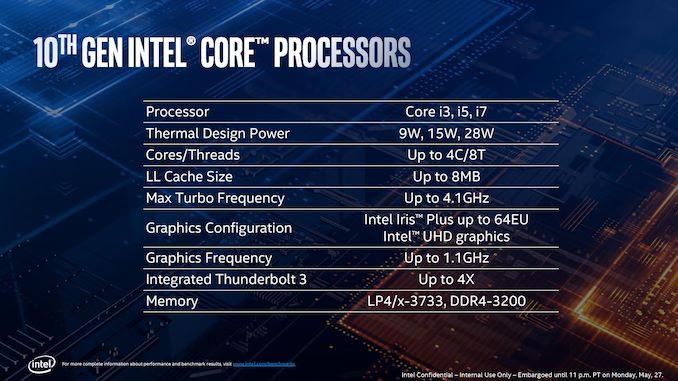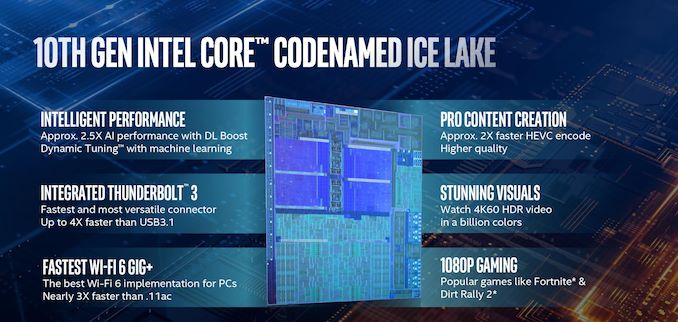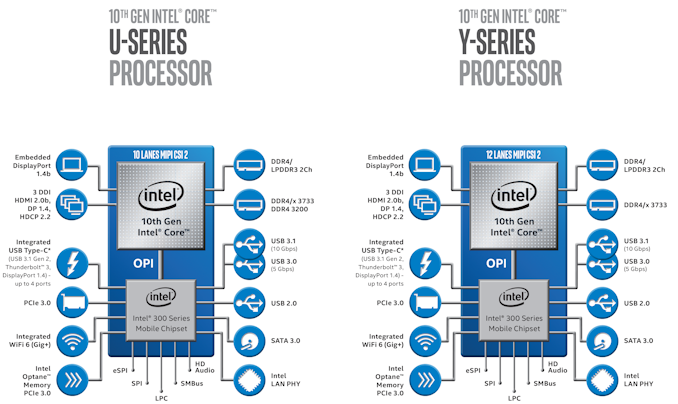Intel Begins Commercial Shipments of 10nm Ice Lake CPUs to OEMs
by Anton Shilov on July 26, 2019 5:30 PM EST
Intel has begun shipments of its 10th generation Core "Ice Lake" processors as of the second quarter, according to the company in an earnings call this week. Made using Intel’s 10nm process technology, these laptop CPUs were qualified by OEMs earlier in 2019 and are on track to reach the market inside mobile PCs by the holiday season.
As reported, Intel began to produce Ice Lake processors in the first quarter in a bid to build up inventory to support a high-volume launch in the second half of the year. The processors passed qualification by PC makers in Q1 – Q2, and then Intel started to ship them for revenue later in the quarter, which was a little bit earlier than anticipated by various market observers. Keeping in mind the lead-time required to get assembled PCs on to store shelves, Ice Lake-powered PCs are well on track to hit the market in Q4 with some machines possibly reaching retailers earlier than that.
Bob Swan, CEO of Intel, stated the following:
- “We began shipping Ice Lake client [CPUs] in the second quarter supporting systems on the shelf for the holiday selling season.”
Intel formally introduced its laptop-focused Ice Lake-U and Ice Lake-Y CPUs, which are based on the Sunny Cove microarchitecture, in late May. Officially called ‘Intel 10th Generation Core’ processors, the family includes 11 chips (ranging from Core i3 to Core i7) featuring two or four general-purpose CPU cores as well as various GPU configurations and coming to market with 9W, 15W, and 28W TDP variants.
On the CPU side of things, Intel promises an average 18% raw clock-for-clock performance uplift compared to the Skylake core released in 2016 (which has been used with small tweaks since then) along with VNNI and Cryptographic ISA instructions. On the GPU side of matters, Ice Lake CPUs will integrate Intel’s Gen11 graphics core with up to 64 execution units, with Intel promising significant performance improvements as well. The updated iGPU will also natively support DisplayPort 1.4 and HDMI 2.0b outputs as well as HDCP 2.2 technology.
As is traditional for Intel’s lower-power mobile parts, the new Ice Lake processors will come with on-package chipsets. The new 300-series chipsets for ICL will natively support USB 3.1 Gen 2, Wi-Fi 6 MAC (RF module will be sold separately), PCIe 3.0, and other features.
Overall, Intel’s road to high-volume production of 10nm CPUs has been long and bumpy; but it looks like the company is finally turning a corner in time for their Q4 launch.
Related Reading:
- Intel Unveils 10th Gen Core Ice Lake-U & Ice Lake-Y Mobile CPUs: 10nm Sunny Cove Later This Year
- Intel Starts Qualification of Ice Lake CPUs, Raises 10nm Volume Expectation for 2019
- Intel Teases Ice Lake-U Integrated Graphics Performance
Source: Intel













115 Comments
View All Comments
Rudde - Saturday, July 27, 2019 - link
AMD roadmap has Zen 3 with TSMC N7+ node slated for next year. AMD could be focused on getting higher clocks, but I'm more inclined to believe they will improve IPC instead.Targon - Monday, July 29, 2019 - link
AMD will do both. AMD is working on core design improvements while TSMC improves its fab process. It's not one or the other, unless you do what Intel did, and link design improvements to the fab process, which has severely hurt the company. Why Intel couldn't have put a new design on 14nm is a very good question that I have not seen the answer to.Icehawk - Sunday, July 28, 2019 - link
8th gen is barely a year oldTEAMSWITCHER - Saturday, July 27, 2019 - link
And most people will be running Cinebench R20 benchmark on those cores and ... not ... much ... else.Targon - Monday, July 29, 2019 - link
When you see benchmark results, you see them done on systems that are very clean, with a new install of Windows, and then the test suite. As a result, these benchmarks are NOT being run on the primary systems that are being used for office work. If you have Steam, Origin, Antivirus, plus other things, you are already putting a greater load on the system than what is on systems that are posted for benchmarks.The result, you see less of an advantage to additional CPU cores than people do in the real world.
twtech - Monday, July 29, 2019 - link
I'm hoping the 32C TR3 will not be gimped memory-access wise like the previous generation. I hope it also can hit around 4GHz turbo.Dark42 - Friday, July 26, 2019 - link
So the Max Turbo of 4,1 GHz is indeed much lower than previous generation, how about the base clocks?bobhumplick - Friday, July 26, 2019 - link
the clock are always lower in the first wave of an intel process. the first process is always about power and density. then the second wave, the plus, (14nm+,10nm+, etc) is about higher clocks but sacrifices is a bit of density to do it (for instance 14nm++ is 35 million transistors per mm2 while 14nm was 45, incidently amd 7nm is rumored to only be about 40-55 by the time amd actually uses its own libraries and adapts the 7nm tsmc process to its own needs).so yes, just like broadwell was the first 14nm and sacrificed a lot of clocks so will these. and just like broadwell these chips are mobile focused so clocks dont matter as much, only power.
once intel finally rolls out 10nm for desktops we may see lower clocks but not like these chips. i wouldnt be surprised if a max oc is 4.6-4.8ghz ish. could go as low as 4.4ghz. but then again they could still be reaching 5hgz. maybe thats why they are putting off 10nm desktop cpus for so long. that and cost
i would expect that the next move for intel is to either put some form of backported 14nm sunnycove out which is what i think rocketlake (the 11th gen is). if they could get the same clocks they are getting now and combine it with 18% ipc gains then that would be a competitive chip. even if they only make core counts similar to what they have now they may lose in multithread performance still but for most average consumers lightly threaded defines performance still.
but the sunnycove cores are quite a bit bigger so how do they fix that on 14nm? well they could leave off the igpu and use that space. the igpu on current chips already takes up the exact amount of space as 4 cores. and coincidently rocket lake is listed as having seperate igpu and cores on intel slides. so if they used that space to make these larger cores in the same amount of space they wouldnt really cost any more unless you bought a version equipped with an igpu. current kf cpus with no igpu actually still have an igpu but its just turned off. so no space savings there.
intels 14nm is actually quite cheap by now. their 14nm cpus cost so much now because a) they still demand a premium price because they are still good chips b) the most important part is that they just have a shortage. they cant produce enough.
if intel move igpu and chipset production to samsung, plus move some of their line over to 10nm for mobile and maybe expand some 14nm production where they can then they could afford to make an 8 core 16 thread sunnycove based cpu and it would cost no more to make than an i9. actually with no production shortfall they could make it the next i7 and sell it for well under 400 dollars. that would be a fairly competitve cpu except in production workloads where amd would win by a good margin.
this would hold them over till they could get 7nm EUV going and then skip straight to the less dense, higher clocking, + version of 7nm for desktop.
Kevin G - Friday, July 26, 2019 - link
This is actually the second 'wave' of 10 nm parts. Cannon Lake was the first which actually did ship but in chronically small volumes due to manufacturing issues.It should be noted that for desktop, Intel has not committed to bringing 10 nm parts to it in 2019 or 2020 with the possible exception of HEDT. Thus far Ice Lake is for mobile and server which carries them until 2021.
Rocket Lake could leverage some of Intel's new packaging technologies but that too is currently targeted at mobile where physical space constraints can justify the price premium and server for scalability. Much like the lack of 10 nm desktop chips on their roadmap for 2019/2020, these advanced packaging technologies will likely come to desktop last.
Intel is pretty much treading water until 2021 but their line up for that year on their road maps does look very interesting.
YoloPascual - Saturday, July 27, 2019 - link
I bet 500 bucks we will not see desktop 10nm at all.